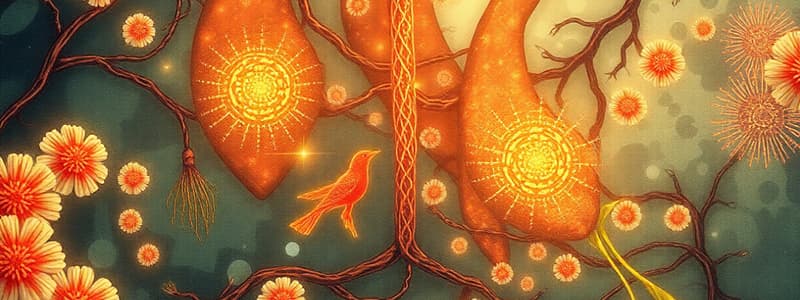Podcast
Questions and Answers
What is the definition of cellular respiration?
What is the definition of cellular respiration?
A series of biochemical reactions in cells that involve the breakdown and oxidation of organic molecules, primarily sugars, to release energy.
What are the two main types of cellular respiration?
What are the two main types of cellular respiration?
- Cellular and Mitochondrial
- Aerobic and Anaerobic (correct)
- Glycolysis and Krebs Cycle
- Photosynthesis and Respiration
What is the purpose of cellular respiration?
What is the purpose of cellular respiration?
Living organisms require energy for movement, maintaining constant body temperature, anabolic processes, and active transport.
Aerobic cellular respiration occurs in the absence of oxygen.
Aerobic cellular respiration occurs in the absence of oxygen.
What is the name of the process that converts glucose into pyruvate?
What is the name of the process that converts glucose into pyruvate?
Where does glycolysis take place?
Where does glycolysis take place?
The link reaction occurs in the mitochondrial matrix.
The link reaction occurs in the mitochondrial matrix.
The Krebs cycle takes place in the mitochondrial matrix.
The Krebs cycle takes place in the mitochondrial matrix.
The electron transport chain occurs in the outer mitochondrial membrane.
The electron transport chain occurs in the outer mitochondrial membrane.
What are the products of glycolysis?
What are the products of glycolysis?
What molecule assists in the process of moving acetyl-CoA into the Krebs cycle?
What molecule assists in the process of moving acetyl-CoA into the Krebs cycle?
What are the products of the Krebs cycle?
What are the products of the Krebs cycle?
What is the role of NADH and FADH2 in cellular respiration?
What is the role of NADH and FADH2 in cellular respiration?
What is the main objective of the electron transport chain?
What is the main objective of the electron transport chain?
What is the name of the process that uses the proton gradient to generate ATP?
What is the name of the process that uses the proton gradient to generate ATP?
What is the final electron acceptor in the electron transport chain?
What is the final electron acceptor in the electron transport chain?
The electron transport chain is a series of redox reactions.
The electron transport chain is a series of redox reactions.
What are the two shuttle systems that transport energy from NADH across the mitochondrial membrane?
What are the two shuttle systems that transport energy from NADH across the mitochondrial membrane?
The malate-aspartate shuttle produces a net gain of 38 ATP molecules per glucose molecule.
The malate-aspartate shuttle produces a net gain of 38 ATP molecules per glucose molecule.
The glycerol-3-phosphate shuttle produces a net gain of 38 ATP molecules per glucose molecule.
The glycerol-3-phosphate shuttle produces a net gain of 38 ATP molecules per glucose molecule.
Anaerobic respiration can produce more ATP than aerobic respiration.
Anaerobic respiration can produce more ATP than aerobic respiration.
What is the main advantage of anaerobic respiration?
What is the main advantage of anaerobic respiration?
What are the two main types of anaerobic respiration?
What are the two main types of anaerobic respiration?
Alcoholic fermentation occurs in some fungi, bacteria, and earthworms.
Alcoholic fermentation occurs in some fungi, bacteria, and earthworms.
What is the main product of lactic acid fermentation?
What is the main product of lactic acid fermentation?
Lactic acid fermentation is a process that requires oxygen.
Lactic acid fermentation is a process that requires oxygen.
What is the importance of anaerobic respiration?
What is the importance of anaerobic respiration?
What are other sources of energy besides glucose?
What are other sources of energy besides glucose?
Lipids can be broken down into fatty acids and glycerol.
Lipids can be broken down into fatty acids and glycerol.
Fatty acids undergo β-oxidation, a process that breaks them down into 3-carbon fragments.
Fatty acids undergo β-oxidation, a process that breaks them down into 3-carbon fragments.
Each β-oxidation cycle produces one ATP, one NADH, and one FADH2.
Each β-oxidation cycle produces one ATP, one NADH, and one FADH2.
What is the main function of the electron transport chain?
What is the main function of the electron transport chain?
How does chemiosmosis work?
How does chemiosmosis work?
The total ATP produced per glucose molecule in aerobic respiration is always 38.
The total ATP produced per glucose molecule in aerobic respiration is always 38.
What is the difference between the malate-aspartate shuttle and the glycerol-3-phosphate shuttle?
What is the difference between the malate-aspartate shuttle and the glycerol-3-phosphate shuttle?
What is the role of inhibitors in the electron transport chain?
What is the role of inhibitors in the electron transport chain?
Rotenone, barbiturate, antimycin A, and HCN are examples of inhibitors of the electron transport chain.
Rotenone, barbiturate, antimycin A, and HCN are examples of inhibitors of the electron transport chain.
Flashcards
Aerobic Cellular Respiration
Aerobic Cellular Respiration
The breakdown of glucose (C6H12O6) in the presence of oxygen to produce carbon dioxide (CO2), water (H2O), and energy in the form of ATP.
Anaerobic Cellular Respiration
Anaerobic Cellular Respiration
The breakdown of glucose in the absence of oxygen, producing a smaller amount of energy and byproducts like lactic acid or ethanol.
Glycolysis
Glycolysis
The first stage of cellular respiration, occurring in the cytoplasm of the cell, where glucose is broken down into pyruvate.
Link Reaction
Link Reaction
Signup and view all the flashcards
Krebs Cycle
Krebs Cycle
Signup and view all the flashcards
Electron Transport Chain
Electron Transport Chain
Signup and view all the flashcards
Chemiosmosis
Chemiosmosis
Signup and view all the flashcards
Substrate-level Phosphorylation
Substrate-level Phosphorylation
Signup and view all the flashcards
Isomerization
Isomerization
Signup and view all the flashcards
Redox Reaction
Redox Reaction
Signup and view all the flashcards
Oxidation
Oxidation
Signup and view all the flashcards
Reduction
Reduction
Signup and view all the flashcards
Phosphorylation
Phosphorylation
Signup and view all the flashcards
NADH
NADH
Signup and view all the flashcards
FADH2
FADH2
Signup and view all the flashcards
ATP
ATP
Signup and view all the flashcards
ATP Synthase
ATP Synthase
Signup and view all the flashcards
Alcoholic Fermentation
Alcoholic Fermentation
Signup and view all the flashcards
Lactic Acid Fermentation
Lactic Acid Fermentation
Signup and view all the flashcards
Facultative Anaerobes
Facultative Anaerobes
Signup and view all the flashcards
Obligate Anaerobes
Obligate Anaerobes
Signup and view all the flashcards
Fat Breakdown
Fat Breakdown
Signup and view all the flashcards
Beta-Oxidation
Beta-Oxidation
Signup and view all the flashcards
Protein Breakdown
Protein Breakdown
Signup and view all the flashcards
Gluconeogenesis
Gluconeogenesis
Signup and view all the flashcards
ATP (Adenosine Triphosphate)
ATP (Adenosine Triphosphate)
Signup and view all the flashcards
Electrochemical Proton Gradient
Electrochemical Proton Gradient
Signup and view all the flashcards
Malate-Aspartate Shuttle
Malate-Aspartate Shuttle
Signup and view all the flashcards
Glycerol-3-Phosphate Shuttle
Glycerol-3-Phosphate Shuttle
Signup and view all the flashcards
Study Notes
Cellular Respiration
- Cellular respiration is a series of biochemical reactions in cells. It involves the breakdown and oxidation of organic molecules (primarily sugars) to release energy.
- A portion of the energy is released as heat.
- The remaining energy is stored as chemical energy in the form of adenosine triphosphate (ATP).
- Living organisms need energy for various processes, including movement, maintaining body temperature, anabolic processes, and active transport.
Objectives
- Two main types of cellular respiration are aerobic and anaerobic.
- Key processes involved in cellular respiration include glycolysis, link reaction, Krebs cycle, electron transport chain, and chemiosmosis.
- Facultative anaerobes and obligate anaerobes are different types of organisms based on their oxygen requirements.
- Alcoholic fermentation and lactate fermentation are two examples of anaerobic respiration.
- Other energy sources are also discussed briefly.
Types of Cellular Respiration
- Aerobic Cellular Respiration: Food is completely oxidized using oxygen, producing carbon dioxide and water.
- Anaerobic Cellular Respiration: Food is oxidized without oxygen, producing products like ethanol or lactic acid. This occurs in yeast and bacteria, for example.
Processes Involved in Cellular Respiration
-
Redox Reactions:
- Oxidation: Removal of hydrogen (loss of electrons), transferring the hydrogen to another compound.
- Reduction: Addition of hydrogen (gain of electrons).
- Phosphorylation: Adding a phosphate group to another compound.
-
Substrate-level Phosphorylation: Transfer of a phosphate group from a phosphorylated substrate to ADP, forming ATP.
-
Isomerization: Conversion of a molecule to its isomer, which has the same formula but different arrangements of atoms. The main purpose is to produce ATP for energy.
Stages in Aerobic Cellular Respiration
- Glycolysis: Occurs in the cytoplasm; glucose is broken down into two pyruvate molecules, producing a small amount of ATP and NADH.
- Link Reaction: Occurs in the mitochondrial matrix; each pyruvate is converted to acetyl CoA, releasing carbon dioxide and producing NADH.
- Krebs Cycle (Citric Acid Cycle): Occurs in the mitochondrial matrix; acetyl CoA enters a cycle of reactions, producing ATP, NADH, FADH2, and releasing carbon dioxide.
- Electron Transport Chain: Occurs in the inner mitochondrial membrane; electrons from NADH and FADH2 are passed down a chain of proteins, releasing energy that is used to pump protons (H+) across the membrane.
- Chemiosmosis: Protons (H+) flow back into the matrix through ATP synthase, driving the synthesis of ATP.
Krebs Cycle
- Coenzyme A assists the acetyl (2C) molecule to enter the Krebs Cycle.
- Occurs only in the presence of oxygen.
- Forms NADH and FADH2.
- Key steps include condensation, isomerization, oxidative decarboxylation, oxidative, substrate-level phosphorylation.
Electron Transport Chain
- Involves oxidation and reduction processes.
- Transfers electrons from NADH and FADH2.
- Plays a significant role in ATP production.
- Three proton pumps and two mobile carriers facilitate electron flow.
- The electrochemical gradient drives ATP synthesis.
Importance of Anaerobic Respiration
- Regenerates NAD+ for glycolysis, a necessary step for continued energy production from glucose.
Types of Anaerobic Respiration (Fermentation)
- Alcoholic Fermentation: Pyruvate is converted into ethanol and carbon dioxide, regenerating NAD+. This process occurs in yeast and some bacteria.
- Lactic Acid Fermentation: Pyruvate is converted into lactate, regenerating NAD+. This process occurs in some animal muscle cells during strenuous activity.
Other Energy Sources
- Fats—Fatty acids and glycerol are broken down to generate ATP.
Studying That Suits You
Use AI to generate personalized quizzes and flashcards to suit your learning preferences.




